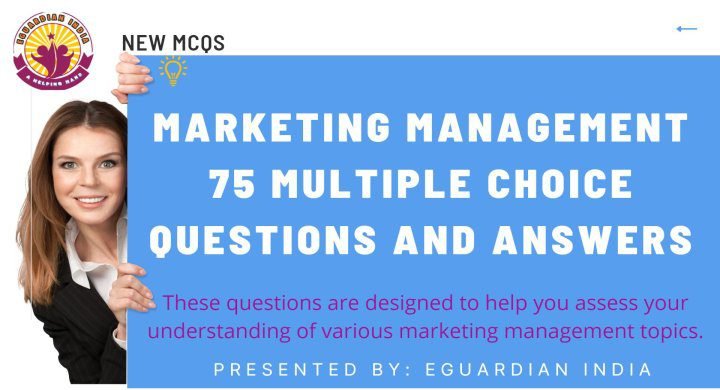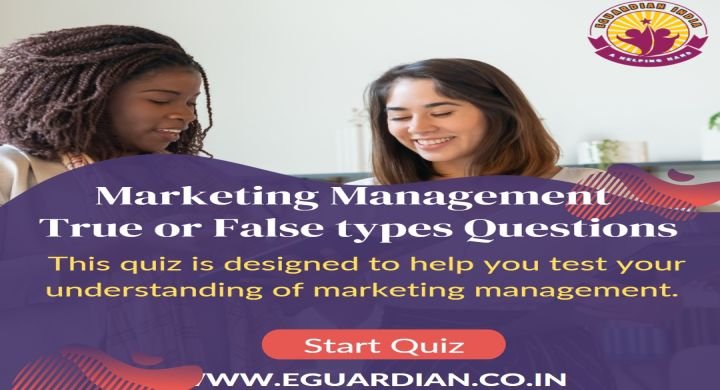Marketing Management Multiple Choice Questions and Answers
Marketing Management Multiple Choice Questions and Answers for Preparation for Academic and Competitive Examinations.
Marketing management is a complex and ever-changing field that requires continual adaptation and innovation to remain competitive. As such, it is essential for marketing professionals to have a strong comprehension of the concepts at hand, which can be verified through 75 multiple choice questions.
Brief Introduction and Definition of Marketing Management
1. In simple terms, marketing is the process of creating value for a company by attracting and retaining customers.
2. To be successful in marketing, businesses must have a clear understanding of their target market and what they want from the product or service.
3. Marketing strategies can be divided into three main categories: product, price, and place.
4. It is essential for businesses to track customer reactions to their products and changes to their marketing campaigns in order to fine-tune their strategies accordingly.
5. There are many different tools and techniques that businesses can use to market themselves, including advertising, public relations, direct mailings, and online presence.
6. The most important part of any marketing plan is execution; if a business doesn’t put its plans into action, it will likely fail in its efforts to achieve success.
Marketing Management Multiple Choice Questions and Answers
The following questions are designed to help you assess your understanding of various marketing management topics.
1. The word’market’’ is derived from the Latin word ___.
Answer: Mercatus
2. In its strict meaning, the market does not necessarily mean a place of exchange. (True / False)
Answer: True
3. Although physical markets are still vital, ___ supported by IT networks such as the internet have become the largest and most liquid.
Answer: Virtual marketplace
4. When exchanges are confined within a family or close members of the family, such a market can be called?
Answer: Family market
5. Foreign exchange market is an international market. (True / False)
Answer: True
6. ___ is a market where shares, debentures, bonds, etc., of companies, are purchased or sold.
Answer: Stock exchange market
7. ___ refers to all those activities involved in identifying the present and potential requirements of the consumers for goods and services.
Answer: Marketing
8. In the words of ___, “Marketing is that phase of business activity through which human wants are satisfied by the exchange of goods and services.”
Answer: J.F. Pyle
9. According to Cundiff and Still, “Marketing is the business process by which ___ are matched with the market and through which transfers of ownership are affected.”
Answer: Products
10. Name the system of exchange that existed in the initial stage of marketing.
Answer: Barter
11. State true or false: In the pre-industrial period, the difficulties of the barter system were removed by adopting common mediums of exchange like cows, pigs, slaves, shells, and sheep.
Answer: True
12. The creation of modern marketing is the result of ___
a) Industrial Revolution
b) Barter system
c) Decentralised exchange
d) Pre-industrial period
Answer: a) Industrial Revolution
13. ___ is a particular method of doing an activity, generally involving a series of steps or operations.
Answer: Process
14. Which of the following is not an element of the traditional marketing mix?
a) Product
b) Pricing
c) Promotion
d) Process
Answer: d) Process
15. Production and distribution depend largely on ___.
Answer: Marketing
16. If production is less than demand, prices shoot up, resulting in ___.
Answer: Inflation
17. Marketing is a connecting link between the consumer and the ___.
Answer: Producer
18. Collecting marketing information is a marketing function that’s related to ___.
a) Exchange
b) Physical supply
c) Facilitating
d) Marketing mix
Answer: c) Facilitating
19. The functions of ___ refer to those functions which are concerned with the creation of place and time utilities.
Answer: Physical supply
20. ___ and grading are facilitating functions.
Answer: Standardisation
21. ___ is an act of obtaining a desired product or service from someone by offering something in return.
Answer: Exchange
22. Marketing, involves the exchange of a product between a seller and a buyer based on ___ considerations.
Answer: Monetary
23. The ___ concept does not cover all the vital ingredients of marketing.
Answer: Exchange
24. The ___ concept of marketing is one of the oldest marketing concepts.
Answer: Production
25. Which of the following is the criticism against the production concept?
a) Consumers are not given personal attention b) Marketing expenses are costly
c) No efforts are made for reducing the competition
d) There is a large number of buyers and sellers
Answer: a) Consumers are not given personal attention
26. Which of the following marketing philosophy believes and operates with the guiding force that the consumers will prefer those products which are available at the right time and at the right places?
a) Production concept b) Exchange concept
c) Product concept d) Marketing concept
Answer: d) Production concept
27. ___ concept was the marketing philosophy till 1930.
Answer: Product
28. Product concept is that marketing philosophy that believes and operates on the principle that ___ allures consumers.
Answer: Quality
29. One of the criticisms against the ___ concept is the assumption that no marketing effort is required since the quality of the product is good.
Answer: Product
30. The main criticism against the ___ concept is that it gives emphasis on increasing sales volume, and not on consumer satisfaction.
Answer: Selling
31. ___ assumes that any product does not sell itself.
Answer: Selling concept
32. Which of the following concept is a common approach for any marketing effort?
a) Selling
b) Production
c) Marketing
d) Product
Answer: a) Selling
33. In which year did the modern marketing concept come into being and gained momentum?
a) 1950
b) 1960
c) 1970
d) 1990
Answer: a) 1950
34. ___ concept is not just putting sales effort, but, understanding customers’ needs and wants before putting any sales effort.
Answer: Modern marketing
35. According to ___, “the marketing concept holds the key to achieving organizational goals consistent with the needs and wants of the target market and deliver the desired satisfaction more effectively and efficiently than competitors”.
a) Philip Kotler
b) Rajan Nair
c) Stanton
d) American Marketing Association
Answer: a) Philip Kotler
36. The societal marketing concept is also known as the ___ concept or ecological concept.
Answer: a) Human
37. ___ concept serves the business world as well as society as a whole.
Answer: Societal
38. The societal marketing concept has gained momentum since ___.
a) 1980
b) 1940
c) 1985
d) 1970.
Answer: a) 1980
39. ___ concept clearly suggests that marketing risks can be reduced only by knowing and understanding the market.
Answer: Marketing
40. As per marketing concept ___ receive top consideration in all business activities?
Answer: Customers’ needs and wants
41. The most common method for preparing a marketing environmental analysis is to conduct a ___ analysis.
Answer: PESTLE
42. PESTLE analysis stands for analysis of ___ Economic, Social, Technological, Legal, and environmental factors affecting business.
Answer: Political
43. ___ are often factors that a business cannot control.
Answer: External forces
44. What is an abbreviation for Strengths, Weaknesses, Opportunities, and threats?
Answer: SWOT
45. PEST is a useful tool for understanding risks associated with market growth or decline. (T / F)
Answer: True
46. A PEST analysis is used to identify the ___ forces affecting an organization.
Answer: External
47. ___ is an organization of employees formed on a continuous basis for the purpose of securing a diverse range of benefits.
Answer: Trade Union
48. Trade unions are voluntary associations formed for the pursuit of protecting the common interests of its ___.
Answer: Members
49. ___ is a set of understandings or meanings shared by a group of people.
Answer: Culture
50. ___ provides the resources required by the company to produce its goods and services.
Answer: Suppliers
51. To overcome competition, a company must provide greater ___ than its competitors.
Answer: Customer satisfaction
52. ___ market consists of wholesalers and retailers.
Answer: Reseller
53. ___ environment consists of those forces which are external to the firm.
Answer: Macro
54. ___ means the study of the human population in terms of size, density, location, age, gender, race, occupation, and other statistics.
Answer: Demography
55. Political and legal environment are ___ environment factors.
Answer: Macro
56. ___ is a tool of revenue generation for marketing.
Answer: Price
57. ___ are the sub-marketers or intermediaries who distribute the company’s products.
Answer: Distribution channels
58. An advertisement is a tool to grab the attention of an individual and use the attention to communicate a message about the product.
Answer: True
59. Three additional Ps of marketing were introduced to meet the needs of the manufacturing industry.
Answer: False
60. ___ is a systematic arrangement that results in the delivery of service.
Answer: Process
61. ___ refers to the external factors or surroundings which aid the customer in making a judgment about the company.
Answer: Physical evidence
62. ___ Training is crucial for the services industry.
Answer: Behavioural and attitude training
63. ___ is a process by which value is delivered to the customer.
Answer: Marketing
64. The marketing process is a combination of the ___ variables and the ___ variables.
Answer: Environmental, marketing mix
65. The marketing program of the organization is effective only if the components of the marketing mix are properly synthesized into a unified whole.
Answer: True
66. Marketing mix is one of the steps involved in a strategic marketing plan.
Answer: True
67. ___ is a part of the yearly planning process for the marketing area and is also a component of the overall business plan of the organization.
Answer: Marketing plan
68.___ is one of the tasks of the marketing plan, which helps in identifying the favorable and unfavorable factors in the business environment and their impact on the business.
Answer: Analysis of business environment
69. Companies that use price-based strategies use ___ as the competitive advantage.
Answer: Pricing
70. In a differentiation strategy, the company offers a ___ to the buyers by way of differentiation from the competition.
Answer: Unique proposition
You may also like to read more MCQs on Marketing Management
71. An analysis that outlines the route map for the marketing strategy of an organization is called ___.
Answer: Marketing Planning
72. ___ is an important process of integration and coordination within the organization.
Answer: Control
73. Control techniques ensure that marketing objectives are achieved effectively.
Answer: False
74. ___ is the process by which the organizational objectives of the entire company are formulated.
Answer: Strategic corporate planning
75. In an organization, SBU stands for ___
a. Substitute Business Unit b. Sub Business unit
c. Strategic Business Unit d. Standard Business Unit
Answer: (c) Strategic Business Unit
Conclusion:
Marketing Management Multiple Choice Questions can be a great way to test your knowledge of the subject. They can also help you to identify any areas that you may need to focus on more. If you are looking to improve your marketing skills, then consider using marketing management MCQs as a tool to help you achieve your goals.
However, it is important to use other resources as well in order to gain a well-rounded understanding of marketing.
Thanks for visiting our website, if you like the Marketing Management Multiple Choice Questions and Answers please share on social media.
Business Communication MCQ with Answers
Read More MCQs:
- UPES-Marketing MCQs
- Service Marketing MCQs
- Sales Management MCQs
- Marketing Mgt MCQ pdf
- MCQ on International Marketing
- UPES Marketing Management MCQs






you will have an awesome blog right here! would you like to make some invite posts on my blog?
Yes, of course, I would like it, please inform the procedure.
I really enjoy the post.Much thanks again. Much obliged.